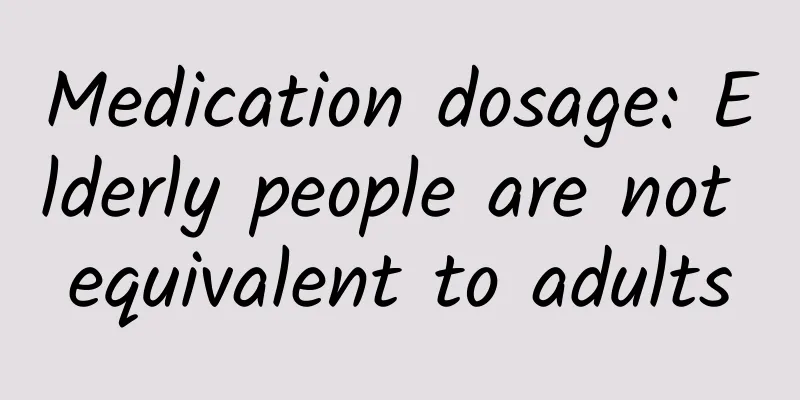Medication dosage: Elderly people are not equivalent to adults

|
When taking medicine for the elderly, in addition to following the principles of whether the medicine is needed, understanding the indications, choosing the appropriate drug dosage form, using as few types of medicine as possible, and correctly treating combined medication, it is also necessary to pay attention to the dosage. Many people think that the elderly are also adults and the dosage of medicine is the same as that of ordinary adults. In fact, this is a misunderstanding. In terms of dosage, the elderly are not the same as adults. The physical fitness and functions of the elderly tend to decline, their detoxification and excretion functions are lower, and their reactions to drugs are different from those of ordinary adults. As a special group, the elderly have their own characteristics in drug absorption, distribution, metabolism, and excretion in the body, so the dosage of drugs should be smaller than that of ordinary adults. Characteristics of drug absorption in the elderly Due to the decrease in gastric acid secretion in the elderly, the pH is increased, the gastrointestinal motility is weakened, the gastric emptying time is prolonged, and the drug stays in the stomach for a longer time, so the drug irritates the stomach of the elderly more than that of the young. In addition, most drugs are absorbed in the small intestine. Since the barrier function of the small intestinal mucosa of the elderly is reduced, the elderly absorb more drugs than the young. Therefore, the dosage of drugs for the elderly should not be too large. The characteristics of drug distribution in the body of the elderly. The elderly have less muscle tissue, more fat tissue, and less total body fluid than the young. Therefore, some water-soluble drugs (such as acetaminophen, aspirin, quinine, etc.) are distributed less in the body tissues and have higher blood drug concentrations. Therefore, the dosage of these drugs should be lower for the elderly than for the young. Characteristics of drug metabolism in the body of the elderly When people reach old age, their body functions have changed greatly from those when they were young, which directly affects the catabolism of drugs. The liver is the main site of drug metabolism. When drugs pass through the liver, part of them are extracted and utilized, and the other part is converted into compounds or substances with therapeutic effects. With age, the weight of the liver continues to decrease. At the age of 21 to 30, the liver weighs about 1,300 grams, and after the age of 60, it drops to about 1,000 grams. Correspondingly, the liver blood flow will also decrease, only 50% of that of young people at the age of 65, and only 30% at the age of 90. These physiological changes directly lead to an increase in the concentration of certain drugs such as phenytoin sodium, aminopyrine, and tetracycline in the body, and a prolonged half-life. For example, the half-life of diazepam in the elderly is 4 to 5 times that of young people. In addition, the elderly often lack vitamins, which affects the activity of liver drug enzymes and slows down their metabolism. These factors prolong the residence time of drugs in the body, and the accumulation of unmetabolized drugs in the body is more than that of young people. Characteristics of drug excretion in the elderly: The kidney is the main organ for drug excretion, and most drugs are excreted through the kidney. As people age, the number of effective renal units in the elderly gradually decreases, causing renal atrophy and reduced renal blood flow, which slows down the rate of drug excretion in the kidneys. This is the main cause of drug accumulation poisoning in the elderly. Therefore, the dosage of drugs for the elderly should not only be relatively small, but the interval between two doses should also be appropriately extended to avoid drug accumulation poisoning. According to the "Chinese Pharmacopoeia": the dosage for people over 60 years old is 3/4 of that for adults; the starting dose of central nervous system depressants should be 1/2 or 1/3 of the adult dose, and the dose should be smaller; the dosage of antibiotics should also be small, generally 1/2 to 2/3 of the normal therapeutic dose. However, drug instructions often indicate adult dosages and child dosages, but not elderly dosages. In fact, elderly people should start taking medications at a small dose. According to age, weight, and physical condition, start with 1/4 of the adult dose, and gradually increase to 1/3, 1/2, 2/3, 3/4, and finally reach the optimal dose suitable for the human body. When you don't know what dosage to take, you should take the minimum dose indicated in the instructions, or take the medicine as prescribed by the doctor. Because the adverse reactions of drugs increase with the increase of drug dosage, especially those drugs with a narrow therapeutic range, overdose may endanger the lives of the elderly. It should be noted that drug dosages are mostly in milligrams, and a few are in grams. When the elderly take a reduced dose, they should carefully check the dosage unit of the drug to avoid adverse consequences. For drugs that have never been used before, you can try a small dose first to see if there are any adverse or allergic reactions. If a small dose of a special drug is difficult to achieve the desired effect, the dose should be determined according to the doctor's advice. In addition, the elderly are also particular about the dosage form of medication. If you can take it orally, try not to inject it, and if you can inject it, try not to drip it. Because the muscles of the elderly have poor absorption capacity for drugs, the pain after injection is more significant and it is easy to form lumps. For some elderly people with difficulty swallowing, granules or liquid preparations can be used, and injections can be given when necessary. Try to use controlled-release agents, because they are less affected by gastrointestinal motility and acidity and alkalinity, and are more suitable for the elderly. Try not to use sustained-release tablets, because they release slowly, increase absorption, and are prone to constipation, which increases absorption and produces toxicity. |
<<: In the face of the new coronavirus, why must we insist on dynamic zero-COVID?
>>: Why is it recommended to eat more vegetables for weight loss?
Recommend
What to do if a 45-year-old woman suffers from insomnia
Insomnia is a health problem that many people wil...
Obstetrician and gynecologist: It’s best not to use sanitary pads if you can avoid it!
If you want to use panty liners, you should try t...
Pessary pictures
Uterine prolapse is a common disease. It mostly o...
What kind of cashews should I buy? Can I eat raw cashews?
Cashews are kidney-shaped nuts with rich nutritio...
What to do if your vaginal discharge is pink and smells bad
Leucorrhea is a white liquid that flows out of th...
Pay attention to this word on the CT report! It is likely to be cancer, don't take it lightly!
Nowadays, everyone pays more attention to physica...
Can orange juice help you sober up? What is the most nutritious way to drink orange juice?
Orange juice not only quenches thirst but also co...
Can I take a shower 15 days after a medical abortion?
Many women choose to have a medical abortion afte...
What are the signs of pregnancy?
Most women will experience pregnancy symptoms aft...
What are the symptoms of polycystic ovary syndrome
Because there are so many people suffering from p...
Why are the dumplings in the restaurant so white? Why are the dumplings in the restaurant so chewy?
As we all know, dumplings are a common type of pa...
Nipple pain in early pregnancy means boy
It is normal to feel breast pain during pregnancy...
What if my lover suddenly disappears but I don't block him or delete him? Can I still contact him after he suddenly disappears?
Breaking up and saying goodbye to each other seem...
What are the dangers of getting angry during women's menstrual period?
Being angry is harmful to the human body, so no o...









